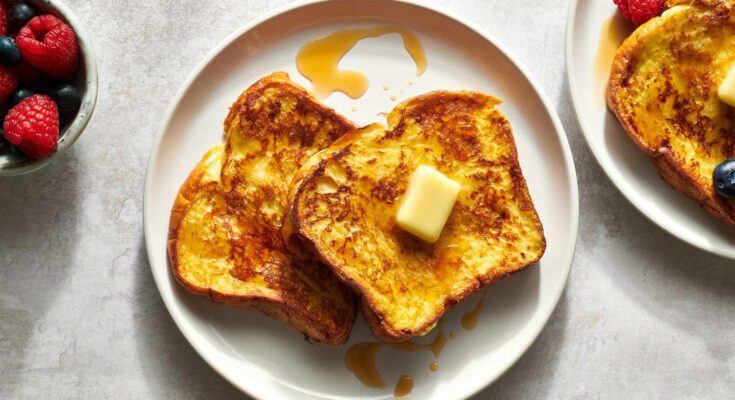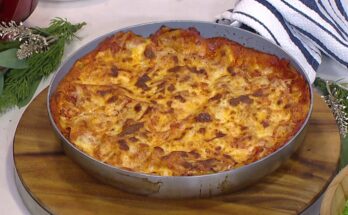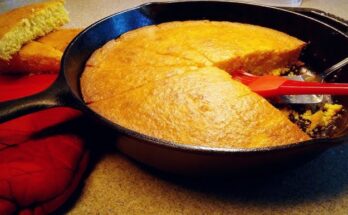French Toast Recipe: French Toast—also fondly known as “eggy bread”—is a breakfast classic that’s loved across the globe. Made by soaking slices of bread in a rich mixture of eggs and milk, then frying them until golden brown, this dish is a perfect balance of crispy on the outside and soft, custardy goodness on the inside. It’s a simple meal that feels indulgent, whether topped with syrup, fruit, or powdered sugar. What makes French Toast so universally adored is its versatility; you can dress it up or down depending on your mood and pantry.
Think of it as a culinary canvas. Want to go sweet? Add vanilla, cinnamon, or nutmeg. Prefer savory? Sprinkle in herbs or cheese. Its adaptable nature is why it appears on menus from diners to five-star brunch spots.
Brief History and Origin
French Toast isn’t actually French. In fact, it predates France by centuries. Traces of this dish go back to Roman times, where stale bread was soaked in a milk and egg mixture and fried—called “Pan Dulcis.” The name “French Toast” first appeared in England in the 17th century, and it was brought to America by early settlers.
In France, it’s called “pain perdu,” meaning “lost bread,” because it was a clever way to use stale bread that would otherwise go to waste. So while the name may be a bit of a misnomer, there’s no denying that French Toast has captured hearts and stomachs worldwide.
Ingredients You’ll Need
Core Ingredients for Classic French Toast
To whip up a plate of golden, fluffy French Toast, you’ll need just a few pantry staples. Here’s the base you can’t skip:
- Bread: Brioche, challah, or even sandwich bread
- Eggs: Typically 2-4 depending on how much you’re making
- Milk: Whole milk gives the best texture, but any milk works
- Sugar: A tablespoon adds a hint of sweetness
- Salt: Just a pinch to balance the flavors
- Vanilla extract: A teaspoon for added depth
These simple ingredients transform plain bread into a breakfast treat that’s both hearty and sweet.
Optional Add-ins and Toppings
Want to elevate your French Toast? Here’s where you can get creative:
- Cinnamon or nutmeg: For warmth and spice
- Cream or half-and-half: Makes the mixture richer
- Butter: For frying and flavor
- Maple syrup or honey: The classic topping
- Fresh fruits: Berries, banana slices, or apple compote
- Powdered sugar: For that Instagram-worthy finish
- Yogurt or whipped cream: Adds a creamy contrast
Mix and match these toppings to personalize your plate and make every bite exciting.
Kitchen Tools Required
Must-Have Tools for Preparation
Before you dive into cooking, make sure you’ve got your tools lined up. Here’s what you need:
- Mixing bowl: For whisking your egg and milk mixture
- Whisk or fork: To beat the eggs smoothly
- Measuring cups and spoons: Accuracy is key
Having everything prepped makes the process seamless and fun.
Tools for Cooking and Serving
To get that golden, crispy crust, cooking tools matter:
- Non-stick skillet or griddle: Essential for even cooking
- Spatula: For flipping your toast without tearing it
- Tongs (optional): Handy for dipping the bread
- Serving plate and napkins: Because presentation counts!
Cooking French Toast doesn’t require fancy gear—just the basics done right.
Step-by-Step French Toast Recipe
Step 1: Choose the Right Bread
Not all bread is created equal when it comes to French Toast. The ideal slice should be thick, slightly stale, and absorbent.
- Best picks: Brioche, challah, or Texas toast
- Stale bread? Even better: Slightly dry bread soaks up the mixture better without falling apart
- Slice thickness: Aim for ¾ inch to 1 inch
Avoid thin sandwich bread unless it’s your only option—thicker bread yields a more satisfying texture and holds up better during cooking.
Step 2: Prepare the Egg Mixture
Now comes the heart of the recipe—the custard-like egg mixture that gives French Toast its signature richness. In a mixing bowl, crack your eggs (about 2 for every 4 slices of bread). Add in your milk—about ½ cup for every 2 eggs. This ratio gives you the perfect balance of creaminess and structure.
Next, mix in your flavor enhancers:
- 1 tsp vanilla extract
- 1 tbsp sugar (optional for sweeter toast)
- ½ tsp cinnamon or nutmeg for warmth
- A pinch of salt to balance the sweetness
Whisk everything together until well combined. The goal is to create a smooth, even mixture that will coat your bread without being too thick or runny. You don’t want clumps of egg whites or sugar pockets—so take your time to get it smooth.
For an extra indulgent touch, swap out some of the milk with heavy cream or half-and-half. It’ll make the toast extra creamy and luxurious.
Step 3: Dip and Soak the Bread
This step makes or breaks your French Toast. Lightly dip your bread slices into the egg mixture. Don’t just do a quick dip—let each side soak for about 10-15 seconds. The bread should absorb the custard but not fall apart.
Here’s how to do it right:
- Place the bread flat in the mixture
- Let it soak until the edges begin to soften
- Carefully flip it over and repeat on the other side
Too long, and you risk soggy slices. Too short, and the toast will be dry inside. The sweet spot is just enough time to let the custard infuse without making the bread too wet. Stale bread helps here—it acts like a sponge.
If you’re making a big batch, line the soaked bread on a tray before cooking. This prevents rushing and ensures even consistency.
Step 4: Cook the French Toast to Perfection
Now it’s time to turn that egg-soaked bread into golden perfection. Heat a non-stick skillet or griddle over medium heat. Add a knob of butter and let it melt, coating the surface completely. Butter adds flavor and gives the toast that beautiful browned crust.
Once the butter is sizzling, gently lay your soaked bread slices on the skillet. Don’t overcrowd—give each slice room to cook evenly.
Cook for about 3-4 minutes per side, flipping once. You’ll know it’s ready to flip when the underside is golden brown and slightly crispy. Use a wide spatula to turn it carefully.
A few tips:
- If the toast is browning too quickly, lower the heat. You want it to cook through without burning.
- If the skillet dries out, add a bit more butter between batches.
- For an extra crispy outside, you can press the toast slightly with a spatula while cooking.
Once both sides are golden and the center is cooked through, transfer the slices to a plate or keep warm in a low oven.
Step 5: Serve and Enjoy
The best part—plating up your delicious creation. French Toast is all about presentation and flavor, so don’t be shy with the toppings.
Here are some irresistible topping combos:
- Classic: Maple syrup and powdered sugar
- Fruity: Fresh berries, banana slices, and whipped cream
- Nutty: Peanut butter and chopped almonds or pecans
- Gourmet: Mascarpone, honey drizzle, and figs
You can also dust a little cinnamon sugar or cocoa powder for flair. If you’re serving a crowd, lay the toast in overlapping rows on a platter with bowls of toppings on the side—brunch buffet style!
Don’t forget coffee or fresh juice on the side to complete the meal.
Tips for the Best French Toast
Common Mistakes to Avoid
Even the simplest recipes can go wrong if you miss the basics. Here are some common French Toast blunders and how to avoid them:
- Using thin or fresh bread: It breaks apart and doesn’t absorb the custard well.
- Under-soaking or over-soaking: Too little soaking means dry toast; too much makes it mushy.
- Cooking on high heat: This burns the outside before the inside is cooked. Stick to medium.
- Skipping the butter: Butter gives the toast that golden, flavorful crust—don’t replace it entirely with oil.
Keep these in mind and you’ll be on your way to French Toast mastery.
Expert Secrets for Golden, Fluffy Slices
Want your French Toast to turn out restaurant-quality every time? Here are some expert tips:
- Let the custard rest: Give the egg mixture a few minutes after whisking to let air bubbles settle. It results in smoother toast.
- Use a mix of dairy: Combining milk with a bit of cream gives richness without heaviness.
- Double-dip method: For ultra-thick slices, dip once, let sit for a minute, then dip again briefly before frying.
- Use clarified butter: It won’t burn as quickly as regular butter, especially for multiple batches.
- Keep it warm in the oven: While cooking multiple slices, keep finished toast in a 200°F (95°C) oven so everything’s hot when served.
Master these tricks, and your French Toast will become legendary among friends and family.
FAQs about French Toast Recipe
1. What is the best type of bread to use for French toast?
For the best French toast, opt for thick-cut bread like brioche, challah, or French baguette. These types of bread absorb the egg mixture well and provide a rich, fluffy texture.
2. How do I make French toast not soggy?
To avoid soggy French toast, use slightly stale bread and cook on medium heat. This ensures the outside gets crispy while the inside remains soft but not too moist.
3. Can I make French toast without milk?
Yes, you can make French toast without milk! Substitute milk with dairy-free alternatives like almond or oat milk, or simply use water if you’re in a pinch.
4. What toppings go well with French toast?
Popular toppings include maple syrup, powdered sugar, fresh berries, whipped cream, and even savory options like bacon or cream cheese. Feel free to get creative!
5. Can I freeze French toast?
Yes, French toast freezes well. Let it cool completely, then store it in a freezer-safe bag for up to 2 months. Reheat in the toaster or oven for a quick breakfast.
6. How can I make my French toast healthier?
To make a healthier version, use whole-grain bread, almond milk, and reduce the sugar in the egg mixture. You can also top it with fresh fruit instead of syrup.
Conclusion
French toast is a dish that truly everyone can enjoy. From choosing the right bread to adding your favorite toppings, there are endless ways to customize it to your taste. Whether you like it sweet, savory, or somewhere in between, French toast is a versatile, delicious meal that can be enjoyed any time of the day. So, grab your ingredients, follow the steps, and you’ll have a plate of perfect French toast in no time!
References
To ensure accuracy and provide additional resources for further reading, here are some reputable sources related to the French Toast recipe:
- Allrecipes – Classic French Toast Recipe: This well-established cooking site provides an in-depth guide on preparing traditional French toast, including tips and variations. Read More.
- Bon Appétit – How to Make French Toast: A comprehensive tutorial from a top-tier food publication that offers step-by-step instructions and helpful advice on achieving the perfect texture and flavor. Explore Here.
- Serious Eats – French Toast Techniques: This article delves into the science behind making French toast and offers expert suggestions for improving your recipe. Learn More.
These sources will provide further insights and details to enhance your French Toast cooking skills.



